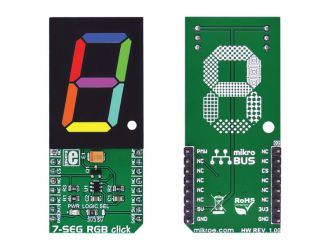
We strongly encourage users to use Package manager for sharing their code on Libstock website, because it boosts your efficiency and leaves the end user with no room for error. [more info]

Rating:
Author: MIKROE
Last Updated: 2019-05-23
Package Version: 1.0.0.1
mikroSDK Library: 1.0.0.0
Category: LED segment
Downloaded: 2703 times
Not followed.
License: MIT license
7-SEG RGB click carries a full color single 7 segment digit display. The click is designed to run on either 3.3V or 5V power supply. It communicates with the target microcontroller over the CS, and PWM pin on the mikroBUS line.
Do you want to subscribe in order to receive notifications regarding "7-SEG RGB click" changes.
Do you want to unsubscribe in order to stop receiving notifications regarding "7-SEG RGB click" changes.
Do you want to report abuse regarding "7-SEG RGB click".

Library Description
The library covers all the necessary functions to control 7-SEG RGB click board.
Key functions:
Examples description
The application is composed of the three sections :
void applicationTask()
{
uint8_t cnt_i;
uint8_t cnt_j;
for ( cnt_i = 0; cnt_i < 10; cnt_i++ )
{
for ( cnt_j = 10; cnt_j > 0; cnt_j-- )
{
c7segrgb_setSevenSegment( _CHARACTER_TABLE[ cnt_i ], 4 * cnt_i, 4 * cnt_j, cnt_i * cnt_j );
Delay_100ms();
}
}
c7segrgb_setSevenSegment( _C7SEGRGB_POINT, 10, 10, 10 );
Delay_1sec();
c7segrgb_setSevenSegment( _C7SEGRGB_ZERO, 40, 40, 40 );
Delay_1sec();
c7segrgb_setSevenSegment( _C7SEGRGB_ONE, 40, 0, 0 );
Delay_1sec();
c7segrgb_setSevenSegment( _C7SEGRGB_TWO, 0, 40, 0 );
Delay_1sec();
c7segrgb_setSevenSegment( _C7SEGRGB_THREE, 0, 0, 40 );
Delay_1sec();
c7segrgb_setSevenSegment( _C7SEGRGB_FOUR, 40, 0, 40 );
Delay_1sec();
c7segrgb_setSevenSegment( _C7SEGRGB_FIVE, 0, 40, 40 );
Delay_1sec();
c7segrgb_setSevenSegment( _C7SEGRGB_SIX, 40, 40, 0 );
Delay_1sec();
c7segrgb_setSevenSegment( _C7SEGRGB_SEVEN, 20, 30, 40 );
Delay_1sec();
c7segrgb_setSevenSegment( _C7SEGRGB_EIGHT, 40, 15, 31 );
Delay_1sec();
c7segrgb_setSevenSegment( _C7SEGRGB_NINE, 20, 10, 30 );
Delay_1sec();
RGB_CONTROL_BIT = 0;
}
Additional Functions :
Other mikroE Libraries used in the example:
One_WireUART​ConversionAdditional notes and informations
Depending on the development board you are using, you may need USB UART click, USB UART 2 click or RS232 click to connect to your PC, for development systems with no UART to USB interface available on the board. The terminal available in all MikroElektronika compilers, or any other terminal application of your choice, can be used to read the message